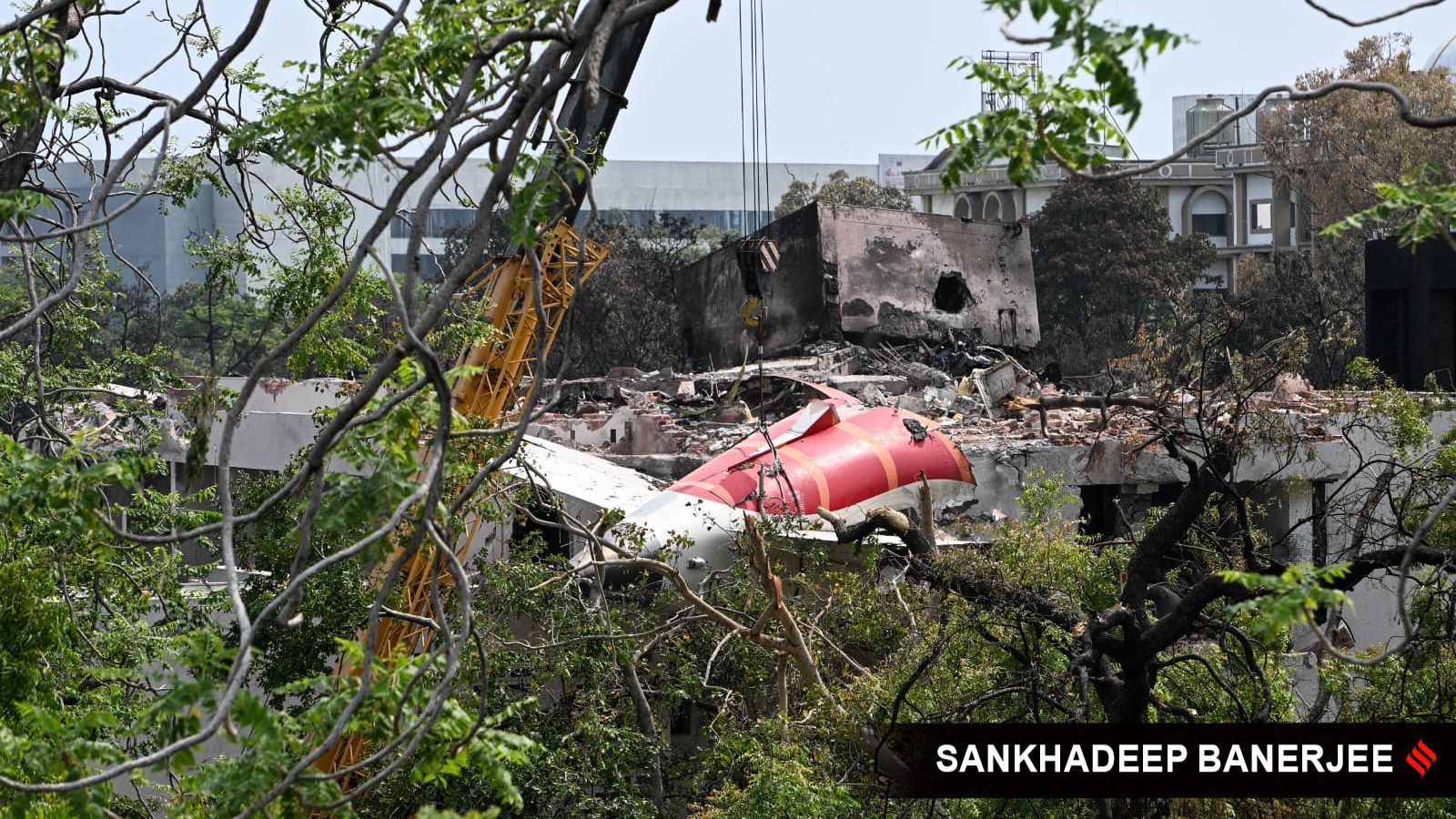A video of the last moments of the doomed Air India Boeing 787-8 could offer new insight into the crash till the time the flight data recorder (FDR) data is analysed. The video, shot by a class 12 student and amateur terrace photographer Aryan Ansari, could challenge a few theories doing the rounds on what might have led to the crash in Ahmedabad—the deadliest disaster involving an Indian airline in decades and the world’s first-ever Boeing 787 crash.
While aviation experts did speculate whether the APU (Auxiliary Power Unit) or RAT (Ram Air Turbine)—both emergency power sources on the aircraft—were deployed, the clearer video sourced directly from Ansari’s phone seems to suggest that the RAT was down. That ties in with what the sole survivor testified to—a loud bang accompanied by the light going out, and then a green light coming in the cabin. And the captain’s mayday call.
The bang could be indicative of a lower hatch giving way and the RAT being deployed automatically, a regulatory source said, while adding that there could be other triggers for a loud sound too. The RAT is essentially a wind turbine located just behind the landing gear console that deploys into the airstream to generate power only when primary and secondary power sources fail. The APU is a smaller turbine engine, typically located in the tail section of the aircraft, that provides electrical and pneumatic power for various on-board systems.
Now, a dual engine failure is the rarest-of-rare event. But if the RAT deployed, it means there was a grave emergency—either a total electrical failure, a debilitating hydraulic failure, or a dual-engine failure, or a combination of these or more factors. Given the appearance of not sufficient lift and loss of thrust, the dual-engine failure theory, which many experts earlier said was not probable but still theoretically possible, could now well be a leading question for investigators to look into.
At a media briefing on Saturday, Civil Aviation Minister K Ram Mohan Naidu had said that investigators will look at all the theories doing the rounds. To be sure, it is too early to jump to any conclusion based on the initial video evidence, considering aircraft are extremely sophisticated and complex machines and detailed and painstaking investigations are required to ascertain the exact cause or combination of causes. All that the clearer video now available does, however, is provide investigators with a crucial clue.
Fuel contamination or clogging of fuel can lead to the engines being starved, leading to a sudden shutdown. A source at the airport did indicate that refuelling took longer than usual (at 42 minutes), but a few others indicated that this was not really an out-of-the-ordinary occurrence for a long-distance international flight with full load. Could it have been bird strikes? The footage available so far does not seem to suggest that. Also, although the Ahmedabad airport has a higher-than-average count of bird hits compared to other airports in the country, it would again be a rarest-of-rare event for a bird hit to disable both engines together. So far, there is no evidence to suggest such a significant bird strike, neither in the initial footage of the aircraft accident, nor at the airfield in the form of bird carcasses.
Coming to the RAT deployment, the device is a last resort for providing basic power to the aircraft when everything else fails. But the RAT is more useful at higher or cruising altitudes, giving the pilots enough time to land at the closest available airfield. Neither time nor altitude was available to the pilots of flight AI-171. The plane had just lifted off the runway and was barely at an altitude of 625 feet—400-odd feet if Ahmedabad airport’s 200-feet elevation is accounted for—before it crashed within moments.
Story continues below this ad
The odds that an aviation accident has a single trigger are rare, and crashes usually have a series of things that go wrong together or one leading to another. The one thing that experts were increasingly converging on before Ansari’s clearer video emerged was that the landing gear of AI-171 was down and flaps were perhaps not retracted, well after the aircraft climbed off the runway. The possibility of an erroneous retraction of the flaps, instead of the gear, was a possibility that some were pointing to. The apparent lack of lift, something that the sole survivor attested to when he said the plane seemed to hang mid-air before going down, seemed to attest to this theory. The RAT deployment. though, changes all of this entirely.
From the available videos, the rate of rotation (the action of pulling back a yoke or centre stick to lift the nose wheel off the ground during takeoff) appears to have been fine, but the undercarriage not being lifted up despite the aircraft being airborne is when things seem to have started going wrong. The landing gear should have been retracted by the time the time the aircraft reached 100 feet, after the “positive rate” of climb is achieved, which is when the captain gives the “gear up” command to the co-pilot for retracting the landing gear. The gear being down, along with incorrect wing flap configuration, together would lead to insufficient lift coupled with significant drag. Even a partial loss of thrust could have potentially impacted the lift given that landing gear was down. The pilots pulling the nose up towards the end seems to suggest a desperate move as the terrain warning would’ve started sounding in the cockpit
While the FDR has been found, and will certainly provide deep insights into the reasons of the crash, the other black box—cockpit voice recorder (CVR)—will also be critical in the investigation, the details of the pilots’ interaction with each other and the air traffic control will emerge from it, and so will the details of the warnings and alarms that would have been sounded in the cockpit before the fatal crash.


